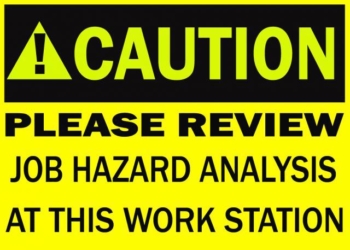One of the most effective tools a safety professional has at reducing injuries and illnesses in the workplace is utilizing a Job Hazard Analysis. A Job Hazard Analysis breaks each individual job into the tasks that are correlated with that job. Then you identify the various hazards that are associated with that task. The JHA focuses on the relationship between the worker, the task, the tools, and the work environment, which allows the safety professional to make the most meaningful and impactful decisions.
Some Benefits of conducting Job Hazard Analysis’s Include:
- Safer work procedures
- Fewer injuries and illnesses
- Lower injury- and illness-related expenses
- Increased worker productivity
- An increased awareness of how to train employees to perform their jobs safely
There are four main steps you should do before conducting your JHA to increase the overall effectiveness. They are as follows:
- Get Your Employees Involved – Safety programs are most effective when there is communication between management and the employees. Getting the employees input allows them to feel part of the process.
- Review your history of injuries, illnesses, and near misses – These records can help you figure out what jobs within your operation need your analysis first and are the most dangerous.
- Ask your employees what hazards are present for their specific job – The employees know the jobs better than anyone, and will be able to give you a detailed analysis of all the hazards associated with each task they perform.
- Create a list which prioritizes which jobs in order you’ll be performing a JHA – Some jobs are more hazardous then others and have the greater chance of injury or illness to occur. Those jobs should be first to be analyzed.
Once you’ve done the above steps you’re ready to conduct a Job Hazard Analysis for your various jobs. The steps that go into conducting an effective Job Hazard Analysis for each job are as follows:
- Break the job into specific tasks performed while doing the job.
- Identify and list the hazards associated for each task.
- Write a hazard description that correlates to each task.
- Create a plan for controlling each hazard associated with the specific task.
- Monitor and review your analysis to ensure the measures you’ve instilled are effective, if not then the plan should be reexamined.
Recent Posts
The U.S. Department of Labor Announces Proposed Rule To Protect Indoor, Outdoor Workers From Extreme Heat
The U.S. Department of Labor has proposed a new rule aimed at protecting workers from extreme heat hazards. This initiative seeks to safeguard approximately 36 [...]
Supreme Court Overturns Chevron Deference: What It Means for Workplace Safety and Regulation
The landscape of federal regulation is set for a seismic shift following a recent Supreme Court decision. On June 28, in Loper Bright Enterprises, et [...]
Navigating the Compliance Maze: How NARFA Simplifies Employee Benefits for Automotive and Trade Industries
In today's complex regulatory environment, businesses in the automotive, roads, fuel, and related industries face unprecedented challenges in managing employee benefits. Recent studies show that [...]




